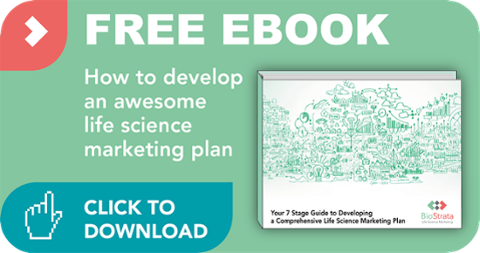The life science market is large, varied and dynamic – not to mention highly competitive. Whether your business is to provide high-end equipment, consumables, medical devices or research services, you need to be able to differentiate yourself from the competition and carve out a unique position in the marketplace.
Fortunately, you will likely already know the unique benefits offered by your products! Therefore, your goal is to effectively communicate these benefits to your target audience(s). To do this, you need to begin with a well-constructed plan. By conducting research, you can use a data-driven method to find out what your customers really need, and the unique value that only you can deliver to them.
So how can you collect and use internal and external research data to build a unique position in the life science market? We typically carry out this process by covering the five components below.
1. Review any existing life science market research data available
Start by reviewing the market landscape. We recommend you make use of the large number of free resources at your disposal. There are various professional market analysts freely sharing their insight, and there are platforms like Slideshare that can quickly get you up to speed with new topics. Kicking things off with a bit of desk-based, independent research can effectively provide you with valuable information without eating into your budget.
2. Carry out an internal brand audit
Take stock of your own assets. You probably have experts and knowledgeable people right under your nose! Your team members are the embodiment of your brand so it’s vital to get their input and make them a key component in developing your unique proposition. Don’t forget that any customer-facing employees, from your sales team to your customer service team, will all have regular contact with your customers and prospects and will have valuable insight through their on-going conversations and feedback. Implement both qualitative and quantitative research methods to gather intel from these in-house sources (although quantitative data is usually only useful for larger companies with at least a few hundred employees). Understanding how your own team view your brand and products, strengths and weaknesses, is vital for shaping your approach.
3. Perform an external audit
It’s now time to start casting your net a little wider: your customers, prospects and even third party associations. This will help you to refine who your targets are, what they care about (e.g. their goals, challenges and pain points) and how best you can prompt them to engage with you. It’s important to look at a variety of stakeholders beyond just the decision makers and influencers. Whether you use online surveys, in-depth interviews or focus groups (or even better, a combination of all three), an external audit provides you with relevant and valuable information - after all, what better way to truly understand the views of your customers than to ask them directly?! The data you collect will go a long way towards making your communications as effective as possible.
4. Undertake a competitor analysis
How do you stack up against the competition? If you want to really make yourself stand out, you need to make sure that your offering is unique. Using a Strengths, Weaknesses, Opportunities and Threats (SWOT) analysis or a Gap analysis can allow you to quickly visualise where best to position yourself. Competitor analysis can show you any potential overlap with a competitor or where those sought-after market niches are. Either way, this allows you to refine your strategy even further.
5. Review your current communications plan
Finally, you need to be sure that the communications you are already engaged in are having the desired effect. Without careful consideration, your voice in the market place can come across as disjointed and inconsistent. A communications audit looks at the value of communications both within your company as well as to key outside audiences. Auditing your existing communications will:
- Highlight whether your employees have the information they need to effectively reach out to your customers and really get their attention.
- Identify any barriers preventing your organisation from achieving maximum growth.
- Show where you perhaps need to add clarity and consistency. You need to make it clear to buyers precisely why they should listen to you.
With this data in hand you can start to define exactly what makes you special and how to communicate this to customers. However, defining your brand position is just one component of creating an effective life science marketing plan. To learn about the other steps, download our free ebook: ‘The 7 Stage Guide to Developing an Effective Life Science Marketing and Communications Plan’.


.jpg?width=454&height=303&name=Whats%20your%20marketing%20strategy%20(comp).jpg)



